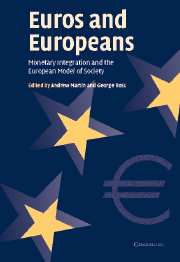Book contents
- Frontmatter
- Contents
- Preface
- List of contributors
- 1 Introduction: EMU and the European social model
- 2 The EMU macroeconomic policy regime and the European social model
- 3 Shaping a polity in an economic and monetary union: the EU in comparative perspective
- 4 Monetary integration and the French model
- 5 EMU and German welfare capitalism
- 6 Maastricht to modernization: EMU and the Italian social state
- 7 Constraint or motor? Monetary integration and the construction of a social model in Spain
- 8 The Netherlands: monetary integration and the Polder model
- 9 Belgium: monetary integration and precarious federalism
- 10 The political dynamics of external empowerment: the emergence of EMU and the challenge to the European social model
- 11 Welfare reform in the shadow of EMU
- 12 Industrial relations in EMU: are renationalization and Europeanization two sides of the same coin?
- 13 Conclusions
- References
- Index of names
- Index of subjects
7 - Constraint or motor? Monetary integration and the construction of a social model in Spain
Published online by Cambridge University Press: 22 September 2009
- Frontmatter
- Contents
- Preface
- List of contributors
- 1 Introduction: EMU and the European social model
- 2 The EMU macroeconomic policy regime and the European social model
- 3 Shaping a polity in an economic and monetary union: the EU in comparative perspective
- 4 Monetary integration and the French model
- 5 EMU and German welfare capitalism
- 6 Maastricht to modernization: EMU and the Italian social state
- 7 Constraint or motor? Monetary integration and the construction of a social model in Spain
- 8 The Netherlands: monetary integration and the Polder model
- 9 Belgium: monetary integration and precarious federalism
- 10 The political dynamics of external empowerment: the emergence of EMU and the challenge to the European social model
- 11 Welfare reform in the shadow of EMU
- 12 Industrial relations in EMU: are renationalization and Europeanization two sides of the same coin?
- 13 Conclusions
- References
- Index of names
- Index of subjects
Summary
Spain's inclusion in 1999 among the first wave of countries participating in the eurozone defied the predictions of many observers who just a few years earlier would have deemed such an outcome improbable. A late entrant into the European Community (EC), the country had been plagued by higher than average inflation and by levels of unemployment that well exceeded those of the rest of the European Union (EU). Its system of labor market regulation, a legacy of a dirigiste past, was seen to be overly protectionist and rigid (particularly concerning layoffs) and hence, a major obstacle to successful labor market adjustment. Its system of social provision, on the other hand, was still under construction when the move toward monetary union was initiated and fell short of other EU states on many dimensions. Given this labor regime, many feared that the adoption of a currency reflecting conditions in the rest of Europe would cause a sharp loss of competitiveness, with dire consequences for employment. That, in turn, might force a radical deregulation of the labor market, ending any prospect of achieving a truly “European” social model in Spain.
This chapter traces Spain's path to EMU and its implications for the country's evolving systems of social protection and industrial relations. After reviewing the basic characteristics of the Spanish social system, it examines why the Spanish government decided to pursue participation in the first wave of EMU at the end of 1998.
- Type
- Chapter
- Information
- Euros and EuropeansMonetary Integration and the European Model of Society, pp. 150 - 173Publisher: Cambridge University PressPrint publication year: 2004

